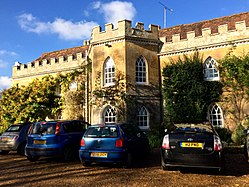Rookley Manor, Up Somborne: Difference between revisions
Created page with "{{Infobox house |name=Rookley Manor |county=Hampshire |picture=Rookley Manor (15822249552).jpg |picture caption=Rookley Manor |os grid ref=SU39543275 |latitude=51.0927 |longit..." |
No edit summary |
||
| Line 15: | Line 15: | ||
|built=Late-15th century | |built=Late-15th century | ||
}} | }} | ||
'''Rookley Manor''' is a country house in [[Up Somborne]] in [[Hampshire]]. It is a Grade II* listed building.<ref name=l>{{NHLE|1303305|Rookley House|grade=II*}}</ref> It stands within the fertile Test Valley | '''Rookley Manor''' is a country house in [[Up Somborne]] in [[Hampshire]]. It is a Grade II* listed building.<ref name=l>{{NHLE|1303305|Rookley House|grade=II*}}</ref> It stands within the fertile Test Valley. | ||
The farmhouse on the state is also Grade II* listed.<ref name=lf>{{NHLE|1095915|Rookley Farmhouse|grade=II*}}</ref> | The farmhouse on the state is also Grade II* listed.<ref name=lf>{{NHLE|1095915|Rookley Farmhouse|grade=II*}}</ref> | ||
==History== | ==History== | ||
From 1776 to 1783 the house was leased as a hunting lodge to HRH Prince Henry, Duke of Cumberland and Strathearn (7 November 1745 – 18 September 1790), third son of Frederick, Prince of Wales, and grandson of King George II.<ref name=v/> His equerry from 1783 to 1790 was Thomas Boothby Parkyns MP (24 July 1755 – 17 November 1800), first son of Sir Thomas Parkyns, 3rd Parkyns Baronet, of [[Bunny Hall|Bunny Park]], Nottinghamshire.<ref name=HoPo/> After Prince Henry's death in 1790, Parkyns took over the lease until his own death on 17 November 1800.<ref name=HoPo>[http://www.historyofparliamentonline.org/volume/1790-1820/member/parkyns-thomas-boothby-1755-1800 PARKYNS, Thomas Boothby (1755-1800)]: History Of Parliament</ref> | From 1776 to 1783 the house was leased as a hunting lodge to HRH Prince Henry, Duke of Cumberland and Strathearn (7 November 1745 – 18 September 1790), third son of Frederick, Prince of Wales, and grandson of King George II.<ref name=v/> His equerry from 1783 to 1790 was Thomas Boothby Parkyns MP (24 July 1755 – 17 November 1800), first son of Sir Thomas Parkyns, 3rd Parkyns Baronet, of [[Bunny Hall|Bunny Park]], Nottinghamshire.<ref name=HoPo/> After Prince Henry's death in 1790, Parkyns took over the lease until his own death on 17 November 1800.<ref name=HoPo>[http://www.historyofparliamentonline.org/volume/1790-1820/member/parkyns-thomas-boothby-1755-1800 PARKYNS, Thomas Boothby (1755-1800)]: History Of Parliament</ref> | ||
Latest revision as of 20:31, 3 November 2022
| Rookley Manor | |
| Hampshire | |
|---|---|
 Rookley Manor | |
| Location | |
| Grid reference: | SU39543275 |
| Location: | 51°5’34"N, 1°26’12"W |
| Village: | Up Somborne |
| History | |
| Address: | Strawberry Lane |
| Built Late-15th century | |
| Country house | |
| Mediæval/Gothic | |
| Information | |
Rookley Manor is a country house in Up Somborne in Hampshire. It is a Grade II* listed building.[1] It stands within the fertile Test Valley.
The farmhouse on the state is also Grade II* listed.[2]
History
From 1776 to 1783 the house was leased as a hunting lodge to HRH Prince Henry, Duke of Cumberland and Strathearn (7 November 1745 – 18 September 1790), third son of Frederick, Prince of Wales, and grandson of King George II.[3] His equerry from 1783 to 1790 was Thomas Boothby Parkyns MP (24 July 1755 – 17 November 1800), first son of Sir Thomas Parkyns, 3rd Parkyns Baronet, of Bunny Park, Nottinghamshire.[4] After Prince Henry's death in 1790, Parkyns took over the lease until his own death on 17 November 1800.[4]
Structure
Although the current two-storey property is dated by some from the early 18th century, the core of the house is constructed around a late-Mediæval timber frame farmhouse structure, dating it to the late 15th century and possibly as late as 1670.
The rendered south-west facade dates from 1707, whilst the front which faces south-east was reconstructed in the late 1700s in a rough-rendered Gothic architecture form. The north side is painted red brick, in English bond pattern which exposes the original timber frame,[1] and is linked to a single-storey service wing. The whole house is topped by a hipped roof, into which windows on some sides extended, mainly using Yorkshire-style sash windows.
Internally entranced through a centrally located open porch on an extending angular bay,[1] the four-panelled door leads to a marble-floored entrance hall and 17th century oak staircase. Many of the rooms retain 18th century fireplaces, whilst the main bedroom retains both its fireplace and complete oak panelling.[1]
Externally, a 20th-century two-storey addition on the north links to an 18th-century two-storey cottage, which further extends to a similarly dated single-storey stable block. All are constructed in matching Flemish bond red brick, with casement windows.[1] There are farming buildings, two walled gardens, two apple orchards and a Lime tree-lined avenue in the immediate surrounding 10.7 acres (4.3 ha) of grounds. From 1795 enclosure of the surrounding farm lands had started to occur, and by 1837 the manor grounds including the associated farm were listed as having a total size of 698 acres.
Outside links
References
- ↑ 1.0 1.1 1.2 1.3 1.4 National Heritage List 1303305: Rookley House (Grade II* listing)
- ↑ National Heritage List 1095915: Rookley Farmhouse (Grade II* listing)
- ↑ Cite error: Invalid
<ref>tag; no text was provided for refs namedv - ↑ 4.0 4.1 PARKYNS, Thomas Boothby (1755-1800): History Of Parliament